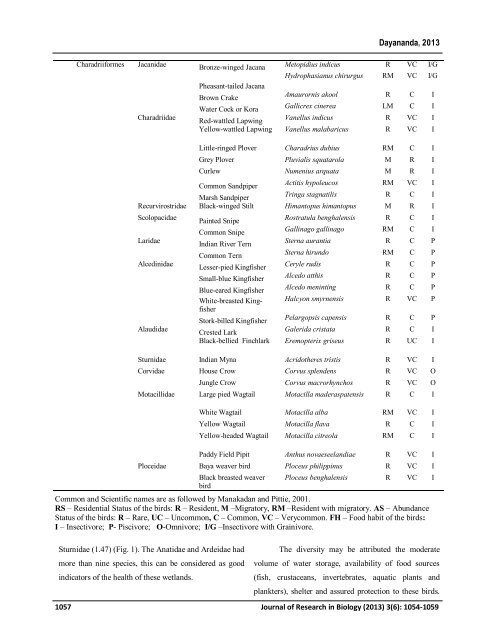Diversity of Wetland dependent birds around the Bhadra Reservoir Project (BRP) area, Karnataka
The study of bird species inhabiting certain wetlands around Bhadra Reservoir Project (BRP), Shivamogga, Karnataka was carried out from February 2008 to January 2010. The total of 68 species of wetland birds belonging to nineteen families and six orders. Of these, Anatidae (15%) and Ardidae (13%) have more than nine species. The diversity may be attributed the moderate volume of water storage, availability of food and assured protection to these birds. Additionally we recorded seven types of migratory birds visiting these ponds. Those include White-necked Stork, Shoveler, Pintail, Grey Plover, Curlew, Ringtailed-fishing Eagle and Black-winged Stilt. All these wetlands are important places for foraging activity of wetland birds. In order to protect these wetland birds, the wetlands should be conserved by controlling encroachment, pollution and other anthropogenic activities.
The study of bird species inhabiting certain wetlands around Bhadra Reservoir Project (BRP), Shivamogga, Karnataka was carried out from February 2008 to January 2010. The total of 68 species of wetland birds belonging to nineteen families and six orders. Of these, Anatidae (15%) and Ardidae (13%) have more than nine species. The diversity may be attributed the moderate volume of water storage, availability of food and assured protection to these birds. Additionally we recorded seven types of migratory birds visiting these ponds. Those include White-necked Stork, Shoveler, Pintail, Grey Plover, Curlew, Ringtailed-fishing Eagle and Black-winged Stilt. All these wetlands are important places for foraging activity of wetland birds. In order to protect these wetland birds, the wetlands should be conserved by controlling encroachment, pollution and other anthropogenic activities.
Create successful ePaper yourself
Turn your PDF publications into a flip-book with our unique Google optimized e-Paper software.
Dayananda, 2013<br />
Charadriiformes Jacanidae Bronze-winged Jacana Metopidius indicus R VC I/G<br />
Charadriidae<br />
Sturnidae (1.47) (Fig. 1). The Anatidae and Ardeidae had<br />
more than nine species, this can be considered as good<br />
indicators <strong>of</strong> <strong>the</strong> health <strong>of</strong> <strong>the</strong>se wetlands.<br />
Hydrophasianus chirurgus RM VC I/G<br />
Pheasant-tailed Jacana<br />
Brown Crake<br />
Amaurornis akool R C I<br />
Water Cock or Kora<br />
Gallicrex cinerea LM C I<br />
Red-wattled Lapwing<br />
Vanellus indicus R VC I<br />
Yellow-wattled Lapwing Vanellus malabaricus R VC I<br />
Little-ringed Plover Charadrius dubius RM C I<br />
Grey Plover Pluvialis squatarola M R I<br />
Curlew Numenius arquata M R I<br />
Common Sandpiper<br />
Actitis hypoleucos RM VC I<br />
Marsh Sandpiper<br />
Tringa stagnatilis R C I<br />
Recurvirostridae Black-winged Stilt Himantopus himantopus M R I<br />
Scolopacidae<br />
Laridae<br />
Alcedinidae<br />
Alaudidae<br />
Painted Snipe<br />
Rostratula benghalensis R C I<br />
Common Snipe<br />
Gallinago gallinago RM C I<br />
Indian River Tern<br />
Sterna aurantia R C P<br />
Common Tern<br />
Sterna hirundo RM C P<br />
Lesser-pied Kingfisher<br />
Ceryle rudis R C P<br />
Small-blue Kingfisher<br />
Alcedo atthis R C P<br />
Blue-eared Kingfisher<br />
Alcedo meninting R C P<br />
White-breasted Kingfisher<br />
Halcyon smyrnensis R VC P<br />
Stork-billed Kingfisher<br />
Pelargopsis capensis R C P<br />
Crested Lark<br />
Galerida cristata R C I<br />
Black-bellied Finchlark Eremopterix griseus R UC I<br />
Sturnidae Indian Myna Acrido<strong>the</strong>res tristis R VC I<br />
Corvidae House Crow Corvus splendens R VC O<br />
Jungle Crow Corvus macrorhynchos R VC O<br />
Motacillidae Large pied Wagtail Motacilla maderaspatensis R C I<br />
White Wagtail Motacilla alba RM VC I<br />
Yellow Wagtail Motacilla flava R C I<br />
Yellow-headed Wagtail Motacilla citreola RM C I<br />
Paddy Field Pipit Anthus novaeseelandiae R VC I<br />
Ploceidae Baya weaver bird Ploceus philippinus R VC I<br />
Black breasted weaver<br />
bird<br />
Ploceus benghalensis R VC I<br />
Common and Scientific names are as followed by Manakadan and Pittie, 2001.<br />
RS – Residential Status <strong>of</strong> <strong>the</strong> <strong>birds</strong>: R – Resident, M –Migratory, RM –Resident with migratory. AS – Abundance<br />
Status <strong>of</strong> <strong>the</strong> <strong>birds</strong>: R – Rare, UC – Uncommon, C – Common, VC – Verycommon. FH – Food habit <strong>of</strong> <strong>the</strong> <strong>birds</strong>:<br />
I – Insectivore; P- Piscivore; O-Omnivore; I/G –Insectivore with Grainivore.<br />
The diversity may be attributed <strong>the</strong> moderate<br />
volume <strong>of</strong> water storage, availability <strong>of</strong> food sources<br />
(fish, crustaceans, invertebrates, aquatic plants and<br />
plankters), shelter and assured protection to <strong>the</strong>se <strong>birds</strong>.<br />
1057 Journal <strong>of</strong> Research in Biology (2013) 3(6): 1054-1059

















